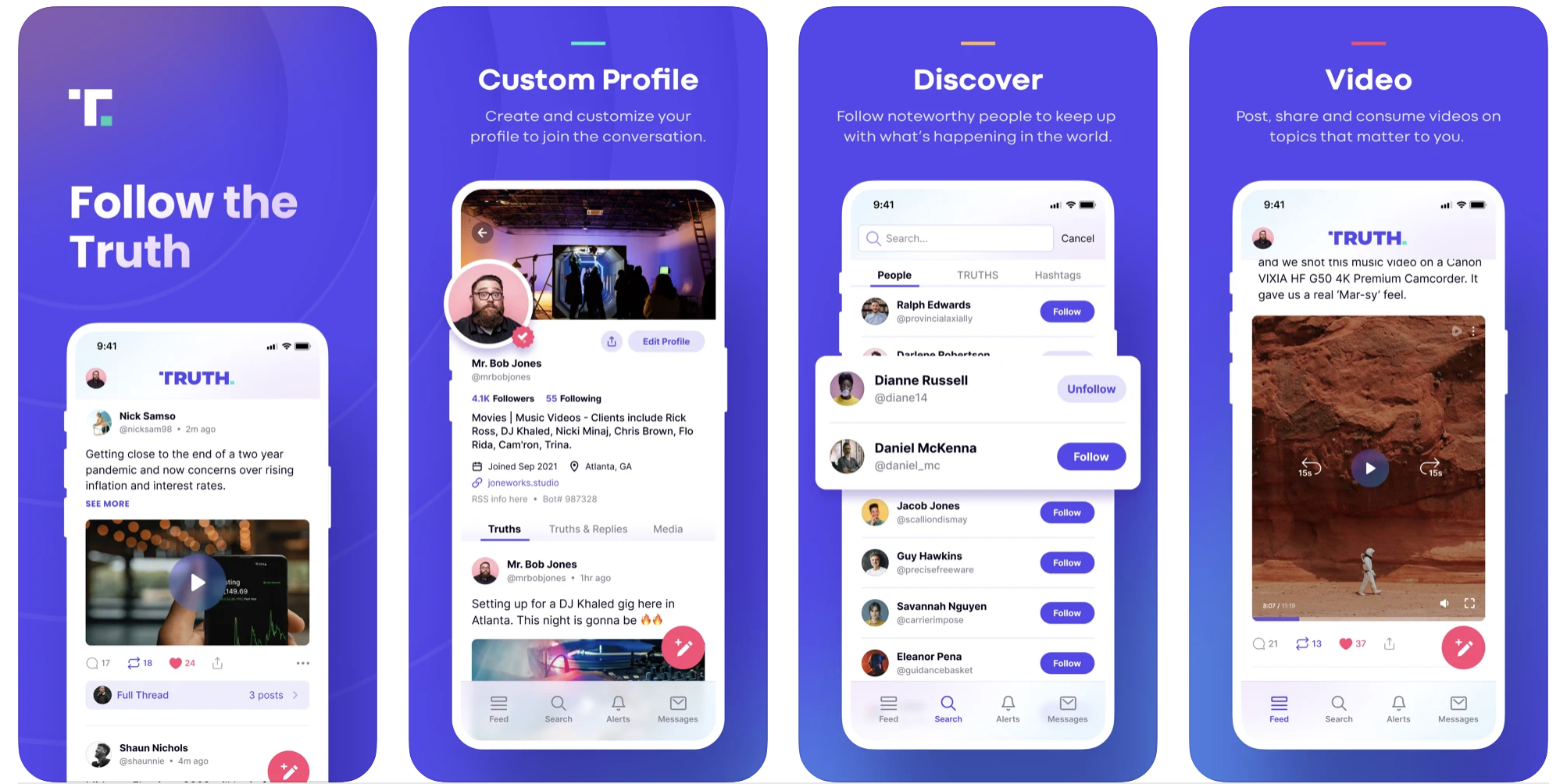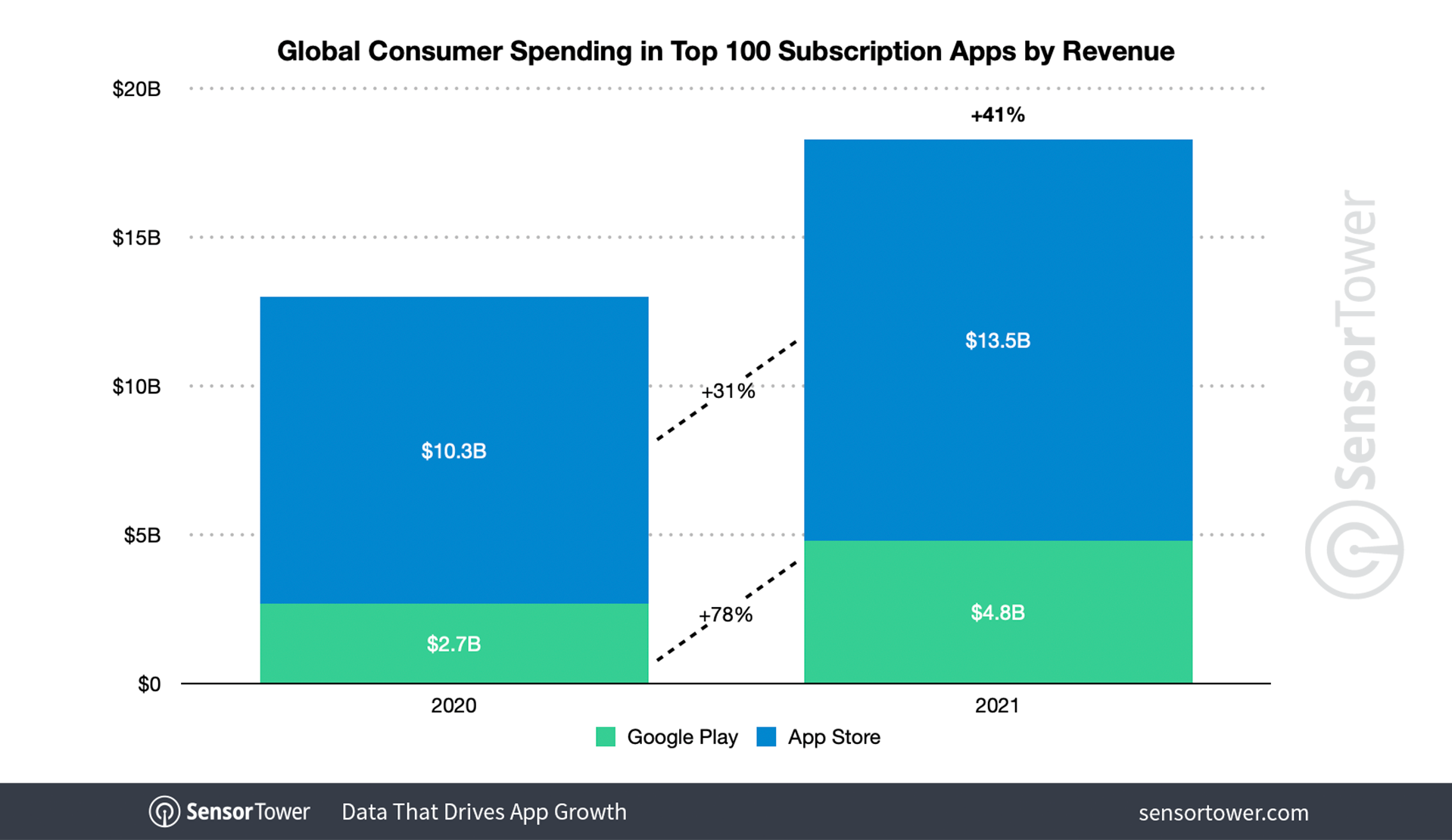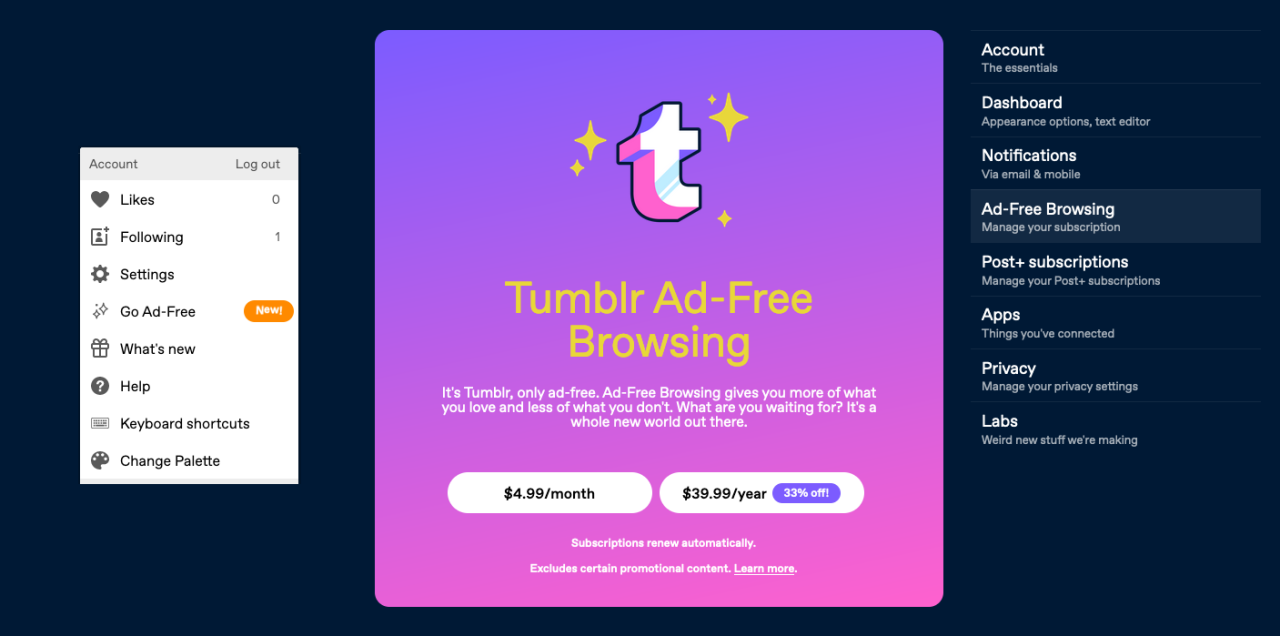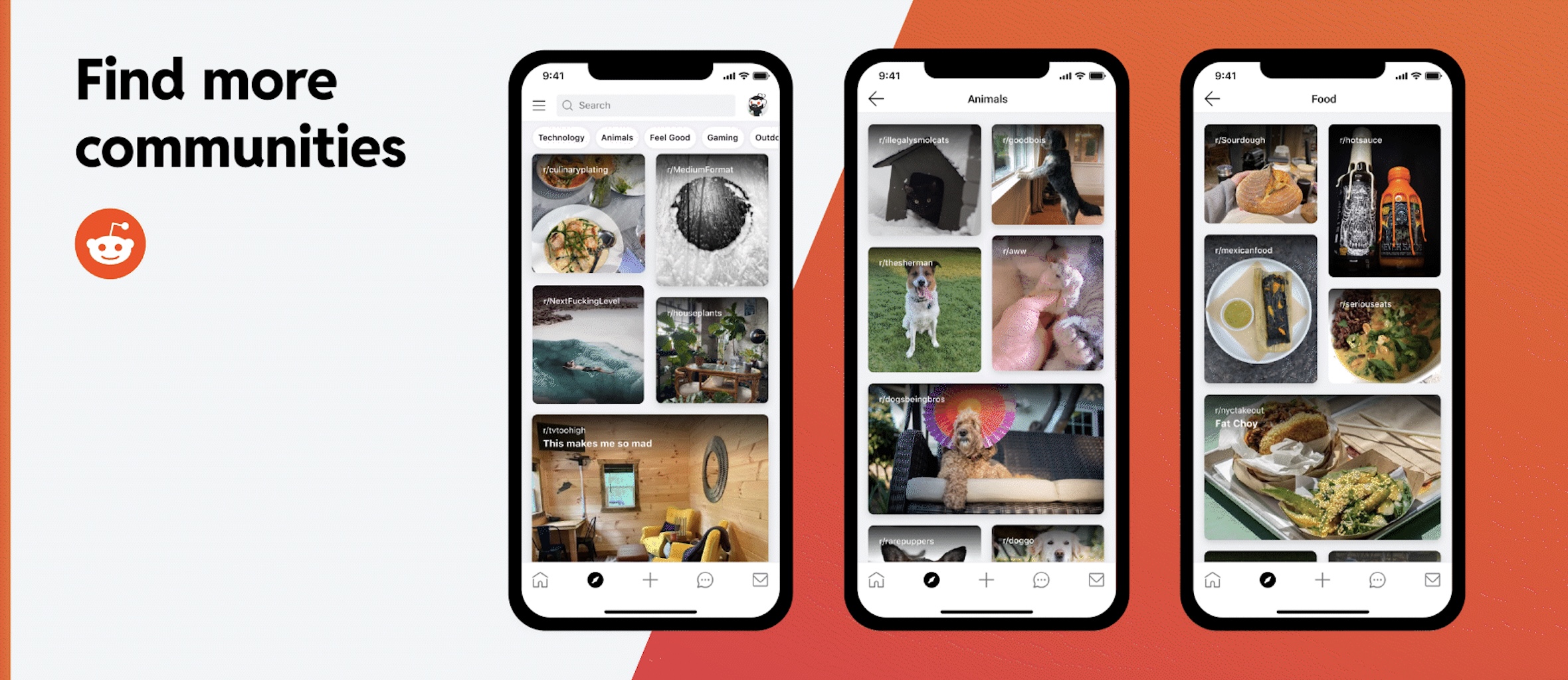Welcome back to This Week in Apps, the weekly TechCrunch series that recaps the latest in mobile OS news, mobile applications and the overall app economy.
The app industry continues to grow, with a record number of downloads and consumer spending across both the iOS and Google Play stores combined in 2021, according to the latest year-end reports. App Annie says global spending across iOS, Google Play and third-party Android app stores in China grew 19% in 2021 to reach $170 billion. Downloads of apps also grew by 5%, reaching 230 billion in 2021 and mobile ad spend grew 23% year-over-year to reach $295 billion.
In addition, consumers are spending more time in apps than ever before — even topping the time they spend watching TV, in some cases. The average American watches 3.1 hours of TV per day, for example, but in 2021, they spent 4.1 hours on their mobile device. And they’re not even the world’s heaviest mobile users. In markets like Brazil, Indonesia, and South Korea, users surpassed five hours per day in mobile apps in 2021.
Apps aren’t just a way to pass idle hours, either. They can grow to become huge businesses. In 2021, 233 apps and games generated over $100 million in consumer spend, and 13 topped $1 billion in revenue, App Annie noted. This was up 20% from 2020 when 193 apps and games topped $100 million in annual consumer spend, and just eight apps topped $1 billion.
This Week in Apps offers a way to keep up with this fast-moving industry in one place with the latest from the world of apps, including news, updates, startup fundings, mergers and acquisitions, and suggestions about new apps and games to try, too.
Do you want This Week in Apps in your inbox every Saturday? Sign up here: techcrunch.com/newsletters
Top Stories
TikTok gives a devasting, firsthand view into the Russia-Ukraine war
The world is watching in horror this week as Russia invaded Ukraine, in an aggressive, cold-blooded assault on democracy.
And many people are watching the conflict unfold in real time on TikTok, which has found itself squarely in the middle of the international conversation as a source for firsthand information from the region. And, in a number of cases, misinformation.
While mobile access to live and recorded video from conflict situations definitely isn’t a new phenomenon, there’s something unique about TikTok’s window into the world. Maybe it’s the odd juxtaposition of war footage amid videos of cooking, fashion, dance and humor — a reminder of what life is supposed to be like positioned against the atrocities of the invasion. Or maybe it’s how a short scroll back through the profiles of the creators-turned-citizen journalists shows that, only days ago, they were uploading everyday content, including scenes from their lives with family and friends. Or maybe it’s the fact that TikTok creators have always come across as more “real” than those on Instagram, where polished and perfected images had put them at a distance from their fans — that just makes what’s now happening feel all the more personal when viewed on TikTok.
But the video platform isn’t just delivering an emotional punch; it’s also been providing military intelligence with its videos of weaponry, planes, vehicles, rockets, soldier movements, protests and more, captured in short clips by everyday citizens. A man walking his dog recorded as ballistic missile launchers passed him by; another person filmed as they drove past a convoy of armored fighting vehicles; young adults went live from the underground train stations which have turned into bomb shelters. And so on.
Plus, TikTok’s advanced algorithm plays a role here in getting this footage seen. The more coverage you watch on TikTok, the more you’ll receive on your For You page — TikTok’s personalized feed, which, by its very nature, surfaces videos from people you don’t follow, unlike social rivals. It remains to be seen how or if TikTok will step in to moderate, elevate or suppress any of this content, or handle the onslaught of misinfo, but for the time being, it’s all relatively easy to find.
Trump’s social app debuts

Image Credits: TRUTH Social
Last weekend, the Trump-backed TRUTH Social app launched on the App Store, and gained just over 400,000 downloads by mid-week, per Sensor Tower data. But it’s difficult to calculate if those figures represent true consumer demand — some could be attributed to curiosity seekers or media reporting on the launch, for example, rather than Trump die-hards.
Meanwhile, many of those who did want to engage with the service received error messages upon trying to create an account, and others were placed on a waitlist, according to reports. Some also reported never receiving their email verifications and not being able to move past the verification step. A rocky launch to say the least. Without immediately gaining access, some of the more casual early adopters may not swiftly return — after all, TRUTH Social is still an app, and apps have a limited window to capture a user’s attention before they’re abandoned. Studies have shown that nearly 25% of users will open a newly installed app only once.
And in the case of TRUTH Social, it may have a verified Trump account, but it’s not the only place for conservatives to gather — they also have the Rebekah Mercer-backed app Parler, Gab, Gettr, MeWe, CloutHub and various private social channels.
Another complication is that TRUTH Social could end up being an echo chamber for the right, which could limit its appeal to a mainstream audience who would rather hear from both sides on a given topic, and engage in a debate. But the app could help to stoke fires within Trump’s base; that’s likely its main goal anyway — not toppling Twitter.
Facebook Reels rolls out worldwide

Image Credits: Meta
After publicly launching in the U.S. this past September, Facebook Reels this week became globally available in more than 150 countries. The feature, which is a key part of Meta’s response to the TikTok threat, allows creators to share short-form video content on Facebook or cross-post Reels from Instagram in order to reach a broader audience. Alongside the global rollout, Facebook introduced more creative tools, including Remix, 60-second videos and more. It also detailed new ways for creators to make money from their Reels through advertising, and soon, Stars (virtual tipping).
The company said it’s expanding tests of Facebook Reels Overlay Ads to all Reels creators in the U.S., Canada and Mexico. By mid-March, the test will expand to nearly all the 50+ countries where in-stream ads are already available. These new Overlay Ads are non-interruptive ads, as they sit transparently atop the playing content instead of pausing the video to show the ad. Banner ads appear as a semi-transparent overlay at the bottom of a reel, while stickers are static images that can be placed anywhere within the reel. Creators keep 55% of the ad revenue for the time being. The ability to actually monetize a following could encourage creators to at least keep Facebook in the mix when considering publishing destinations, but it may not be enough to actually unseat TikTok from its current top spot.
Top subscription app revenue grew 41% in 2021

Image Credits: Sensor Tower
A new report from Sensor Tower indicates the top 100 non-game, subscription-based apps saw their consumer spend increase 41% in 2021 to $18.3 billion, up from $13 billion in 2020. And this represents just a small portion (14%) of the overall revenue from in-app purchases across both apps and games, which totaled $131.6 billion in 2021. However, this group’s portion of the market is growing. In 2020, subscription revenue in non-game apps represented just 11.7% of the total consumer spend for the year, for comparison.
The U.S. figures mirrored the global trends when it came to mobile spending on subscriptions, the data showed. Last year, U.S. consumers spent $8.5 billion in the top 100 non-game subscription apps, up 44% from $5.9 billion in 2020 — more sizable growth than the 28% rise seen the year prior. In total, U.S. consumers spent $40.7 billion on in-app purchases in 2021.
Subscriptions have become the dominant means of driving app store revenue. In the fourth quarter, 90 out of the top 100 top-grossing U.S. apps included a subscription. This figure is only slightly down from the 91 in Q4 2020 or the 93 in Q4 2019.
Weekly News
Platforms
- Apple’s iOS 15.4 beta 4 adds a number of new features, including, most notably, the recently announced anti-stalking alerts for AirTag and a new gender-neutral voice option for Siri.
- Apple hasn’t changed its in-app purchase policies to allow third-party payments outside of a couple of markets with specific new regulations, but Paddle is touting how it signed up 1,500 developers who are interested in adopting its alternative payments system if it’s ever allowed.
E-commerce
- Etsy delivered a beat for its Q4 2021 earnings, with $1.11 EPS versus 79 cents expected, and $717 million in revenue, versus $685 million expected. The e-commerce company now has 96.3 million active buyers, also higher than expectations. However, there’s bad news for sellers, who will see transaction fees increase from 5% to 6.5% starting on April 11.
Fintech
- Coinbase beat on revenue in its Q4 2021 earnings, bringing in $2.5 billion, versus $1.94 billion expected. It also saw EPS of $3.32 versus $1.85 expected. But the stock dropped as much as 9% after the company announced Q1 would see a “decline in crypto asset volatility and crypto asset prices,” which would impact retail monthly transacting users (MTUs) and total trading volume.
- Block reported $1.96 billion in bitcoin sales via its Cash App during its Q4 2021, which delivered $46 million in profits. For the full year, Cash App made $10 billion in bitcoin sales, with $218 million in gross profit.
Social

Image Credits: Tumblr
- Tumblr’s latest attempt to make money asks users to subscribe to ditch the ads. The new subscription charges $4.99 per month or a discounted $39.99 per year to remove the ads from your Tumblr feed. Tumblr users tend to be ad sensitive, so this service could possibly gain traction given it will remove the ads across platforms. However, the service can only be enabled via the web — which means it doesn’t have to pay the app stores a commission on the subscription revenue for a feature that works on mobile.
- Facebook’s updated SDK v13.0 for Android will now include a permission request for the Android Advertiser ID by default, in line with the Google Play Services policy on Advertiser IDs.
- TikTok rolled out its recently announced set of safety features to users in Europe. Already live in the U.S., the updates include a new policy around dangerous acts, better reporting tools and promotional campaigns to stop and think before engaging with online challenges, among other things.
- Instagram quietly removed the 10-minute daily time limit setting in the app, in favor of adding longer options after having promised users they would be able to better control their time in-app using the feature.
- Nextdoor published its first-ever transparency report in the hopes of demonstrating to regulators how its community moderation features differentiate it from larger social rivals.
- Reddit debuted a major revamp of its mobile app for the first time in over two years with updated navigation and the addition of a new “Discover Tab.” The latter will offer personalized recommendations of new communities to join based on users’ current subscription, activity and general popularity.

Photos
- Halide’s mobile app was updated with a number of new features, including the ability to work with multiple photos at once (“batch actions”), tweaks to its Grid View and more. But notably, one of its features targets a specific iOS bug that can sometimes prevent Halide from saving photos. In this case, Halide will store a copy of the photo in the app, so you can later try to save it again.
Streaming & Entertainment
- Audio chatroom app Clubhouse introduced a new in-room chat feature that allows users, including both mods and listeners, to communicate in a chat interface while the room is live. Here, users can post texts and emoji to participate in the conversations.
- LinkedIn launched its own podcast network to deliver thought leadership in audio form, apparently. The in-house shows will come from the LinkedIn News team and other industry figures. One show, arriving in the spring, comes from Reid Hoffman, the co-founder and executive chairman of LinkedIn, and will focus on personal entrepreneurship.
- YouTube adopted a TikTok-style feature that adds rings around someone’s profile picture when their channel is livestreaming.
- Data.ai (previously App Annie) highlighted findings that showed how app users spent more than $7.8 billion on their mobile video streaming subscriptions in 2021, among the top 20 streaming apps. That’s up 60% YoY from the $4.9 billion spent in 2020. Time spent in these apps also rose 32% over pre-pandemic levels in 2019.
- Amazon Music has now overtaken Pandora to become the No. 2 streaming app in the U.S. behind Spotify, according to eMarketer/Insider Intelligence. By the end of 2022, Amazon Music will have 52.6 million users in the U.S., up 5.3% over last year. But Pandora’s user base will decline by 6.7%, to 49.1 million, the report said.
Gaming
- Sony’s PlayStation mobile app is making it easier to share PS5 gameplay screenshots and videos with their mobile devices by enabling an automatic sharing feature. The update first rolls out in the Americas.
Productivity and Utilities
- Google is planning to remove the “Lite Mode” feature from Chrome for Android in late March when Chrome version M100 arrives. The feature, previously called Data Saver, was designed for those with slow data connections. Google says it’s sunsetting the feature as it’s seen a “decrease in cost for mobile data” in many countries since the feature’s launch in 2014.
- Ring’s app will work with non-Ring cameras for the first time, starting in April. The app will then support ONVIF-compatible cameras. However, the feature will require a Ring Protect Pro subscription and a Ring Alarm Pro base station. Most ONVIF cameras are commercial grade, and come from makers like Reolink, Amcrest, Panasonic, Bosch, Axis, HikVision and Arecont Vision — not direct Ring rivals like Nest or Arlo.
Government & Policy
- In a speech, the European Union’s head of digital policy, EVP Margrethe Vestager, who also heads the EU’s competition division, took aim at Apple’s recent conduct in the Netherlands, suggesting the tech giant was choosing to pay the fines instead of complying with the Dutch antitrust order that would allow dating apps the ability to make use of third-party payments.
Security & Privacy

Image Credits: Google
- Google’s internal R&D group, Area 120, launched Checks, an AI-powered privacy compliance solution for mobile apps. The freemium solution will be offered to both Android and iOS app developers of all sizes, who will be able to have their apps analyzed then receive a report with actionable insights about how to address the problems that are found. The free tier can be used for completing Google Play’s new Data safety section, while paid tiers add more in-depth privacy and compliance checks, including insights into SDKs being used, and in some cases, access to a human compliance review team.
- A TechCrunch investigation detailed nine Android spyware apps which were installed on around 400,000 smartphones, and connected to servers controlled by Vietnam-based 1Byte.
Funding and M&A
 TikTok star Charli D’Amelio, sister Dixie and parents Marc and Heidi invested in app maker Lightricks, which publishes popular apps like Facetune and Videoleap, among others. The strategic investment remains undisclosed.
TikTok star Charli D’Amelio, sister Dixie and parents Marc and Heidi invested in app maker Lightricks, which publishes popular apps like Facetune and Videoleap, among others. The strategic investment remains undisclosed.
 Mobile game controller Backbone raised $40 million in Series A funding from a celeb-filled list of investors, including Ashton Kutcher (by way of his fund Sound Ventures), The Weeknd, Kevin Hart, Post Malone, Diddy, Amy Schumer and Marshmello. On the tech side, Discord co-founder Jason Citron, Rec Room co-founder Nick Fajt and Sonos CEO Patrick Spence also invested.
Mobile game controller Backbone raised $40 million in Series A funding from a celeb-filled list of investors, including Ashton Kutcher (by way of his fund Sound Ventures), The Weeknd, Kevin Hart, Post Malone, Diddy, Amy Schumer and Marshmello. On the tech side, Discord co-founder Jason Citron, Rec Room co-founder Nick Fajt and Sonos CEO Patrick Spence also invested.
 Pakistan-based payments and messaging super app NayaPay raised $13 million in seed funding from Zayn Capital, MSA Novo, Graph Ventures and others. The fintech aims to onboard 5 million users over the next five years.
Pakistan-based payments and messaging super app NayaPay raised $13 million in seed funding from Zayn Capital, MSA Novo, Graph Ventures and others. The fintech aims to onboard 5 million users over the next five years.
 Indian neobank app Niyo raised $100 million in Series C funding co-led by Accel and Lightrock India. The app now has more than 4 million customers using its banking and wealth management services.
Indian neobank app Niyo raised $100 million in Series C funding co-led by Accel and Lightrock India. The app now has more than 4 million customers using its banking and wealth management services.
 Travel app Hopper acquired Paris-based Smooss, which helps travelers with alternate routes when flights are disrupted, for an undisclosed sum. The deal brings a partnership with Air France-KLM with it.
Travel app Hopper acquired Paris-based Smooss, which helps travelers with alternate routes when flights are disrupted, for an undisclosed sum. The deal brings a partnership with Air France-KLM with it.
 Astrology app Sanctuary acquired astrology video platform Hey Hero, which offers asynchronous video reading from astrologers and psychics. The companies didn’t disclose the deal terms.
Astrology app Sanctuary acquired astrology video platform Hey Hero, which offers asynchronous video reading from astrologers and psychics. The companies didn’t disclose the deal terms.
 Mark Cuban-backed live creator platform Fireside is currently raising a $25 million Series A round, valuing the business at $125 million, as it plans to make a push into web3.
Mark Cuban-backed live creator platform Fireside is currently raising a $25 million Series A round, valuing the business at $125 million, as it plans to make a push into web3.
 Language learning app EWA, which uses excerpts from films and TV to help teach, raised $2.7 million in seed funding from Day One Ventures and Elysium. The app has an annual revenue run rate of $32.4 million and 3.5 million MAUs after 51 million downloads.
Language learning app EWA, which uses excerpts from films and TV to help teach, raised $2.7 million in seed funding from Day One Ventures and Elysium. The app has an annual revenue run rate of $32.4 million and 3.5 million MAUs after 51 million downloads.


